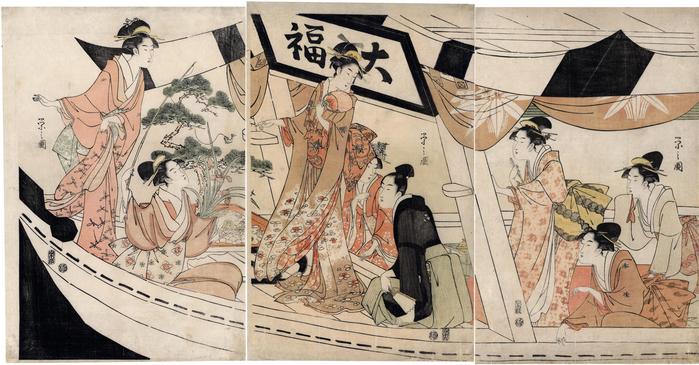Hosoda Eishi (細田栄之) (artist late 1750s - late 1820s)
Party on the Daifuku (大福) pleasure boat
1796 – 1797
29.5 in x 15 in (Overall dimensions) color woodblock print
Signed: Eishi zu (栄之図)
Publisher: Izumiya Ichibei (senichi-han seal)
(Marks 180 - seal 25-365)
Censor's seal: kiwame
Museum of Fine Arts, Boston
Ritsumeikan University (center panel in b/w)
Ritsumeikan University (left panel in b/w)
Lyon (another example)
Ritsumeikan University (right panel in b/w)
Muzeum Sztuki i Techniki Japońskiej Manggha, Krakow - the left panel only
Metropolitan Museum of Art - Kiyonaga triptych from ca. 1785
Metropolitan Museum of Art - a different Eishi triptych from ca. 1792
British Museum - Kiyonaga triptych from ca. 1785-88
Cleveland Museum of Art - triptych of women on a pleasure outing on the Sumida - 1790s
Is this a mitate of the arrival of the Takarabune or treasure ship which carries the Seven Propitious Gods into port every New Year's Day?
We know this the lay out of this composition looks like it might have been designed with extra panels on the right and that Eishi sometimes did created such pieces, but in this case, we think that it was always meant to be a triptych. That is why it raises the question of a comparison with the Takarabune. That motif always carried seven god-like figures, but here is shows seven beautiful women with one young man. Thus, seven to seven. Add to that that one of the women is holding a fishing rod with a fish on the end, like Ebisu so often does, white another woman is holding her fan in such a way that at first glace it could be mistaken for Daikoku's mallet-of-plenty.. By inference, the other women represent the other gods who are accompanying the young man. On top of that, the boat is named the 'Daifuku', another New Year's reference. You be the judge, but we believe that this is indeed a mitate presented in the most fashionable way.
****
A young man is entertained by seven young beauties on the Daifuku Pleasure Boat. The woman seated in the left panel has just caught a small fish.
Bibliography: Ukiyo-e taisei 7 (1931), #562; Brandt, Hosoda Eishi (1977), fig. 213, list no. 276; Ukiyo-e shūka 8 (1980), Eishi list, #71
Boating scenes with elegant courtesans are one of Eishi's favorite motifs. There are a number of other multi-panel prints, mainly triptychs, showing variations on this theme. Kiyonaga created similar scenes of pleasure boats almost ten years earlier. (See the links at the Metropolitan Museum and the British Museum above.)
****
Daifuku (大福) means great fortune or good luck. It is also what the first tea of the New Year is called. Perhaps this triptych represents a celebration of that event. However, the inclusion of the irises and the style of clothing would place this setting closer to the fifth month of the year.
A bit of a surprise for us is the use of the sasarindō on the curtains hanging on this boat. That symbol of the combination of the genta flowers and bamboo was a clan crest used by the Minamoto of the Yoritomo branch. What the connection is with a Eishi triptych from ca. 1796 is a puzzle to be resolved sometime.
Izumiya Ichibei (和泉屋市兵衛) (publisher)
beautiful women (bijin-ga - 美人画) (genre)
Historical - Social - Ephemera (genre)
